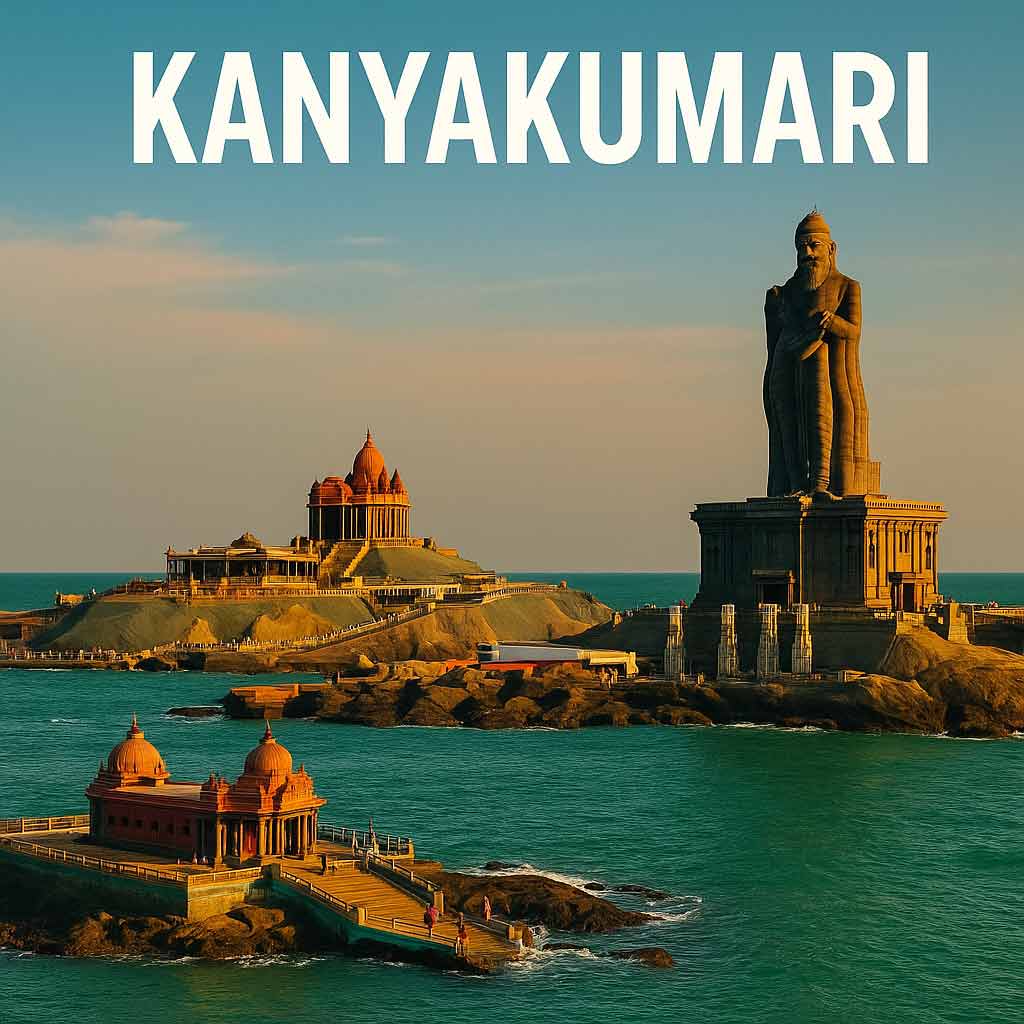Kanyakumari – Tamil Nadu
– Where the Oceans Meet and Cultures Converge

Kanyakumari – Where the Oceans Meet and Cultures Converge
At the southernmost tip of the Indian peninsula lies Kanyakumari, a breathtaking destination where nature’s grandeur, spirituality, and history merge in perfect harmony. Often called the “Land’s End of India,” Kanyakumari is the meeting point of three vast water bodies — the Indian Ocean, the Arabian Sea, and the Bay of Bengal. Located in the state of Tamil Nadu, this coastal town is a place of deep significance — geographically, culturally, and spiritually — offering travelers an experience that is both serene and inspiring.
A Land of Natural Beauty and Sacred Waters
Kanyakumari’s geography is one of its most defining features. Standing on its rocky shores, one can witness the mesmerizing sight of the sun rising and setting over the ocean — a rare spectacle visible from very few places in the world. The Triveni Sangam, where the three seas converge, holds special spiritual significance. The differing shades of the waters can often be seen merging, symbolizing unity amidst diversity.
The Kanyakumari Beach is lined with colorful seashells, swaying palm trees, and the rhythmic sound of waves crashing against the rocks. The View Tower near the shore provides a panoramic glimpse of the confluence, the famous monuments, and the expansive horizon where sky and sea meet endlessly.
The Legend of Kanya Devi
The town derives its name from Devi Kanya Kumari, the virgin goddess who is an incarnation of Goddess Parvati. According to Hindu mythology, she was destined to marry Lord Shiva, but the wedding never took place. She remains eternally celibate, symbolizing purity and devotion. The Kumari Amman Temple, perched near the seashore, is dedicated to her. Pilgrims from across India visit to seek her blessings. The temple’s ancient Dravidian architecture and the powerful spiritual aura of the deity make it a focal point of the town’s identity.
Vivekananda Rock Memorial – A Symbol of Enlightenment
A short ferry ride from the mainland takes visitors to the Vivekananda Rock Memorial, built on a rocky island surrounded by the sea. It was constructed in 1970 to honor Swami Vivekananda, one of India’s greatest spiritual leaders, who meditated here in 1892 before embarking on his mission to spread the message of Vedanta worldwide.
The memorial’s architecture blends traditional and modern Indian styles, with two main halls — one dedicated to Vivekananda and the other to the goddess Bhagavathi. Standing on the rock, surrounded by the vast ocean, visitors often experience a sense of peace and introspection. The spot also offers a stunning view of the sunrise and sunset — a scene that stays etched in memory.
Thiruvalluvar Statue – Tribute to Tamil Wisdom
Adjacent to the memorial stands the imposing Thiruvalluvar Statue, a 133-foot-tall stone sculpture honoring the legendary Tamil poet and philosopher Thiruvalluvar, the author of the Thirukkural. The height symbolizes the 133 chapters of his timeless work on ethics, governance, and love. The statue, visible from afar, is not just an architectural marvel but also a symbol of Tamil pride and intellectual legacy. Together, the statue and the rock memorial embody the spirit of India’s philosophy — blending spirituality, knowledge, and art.
Cultural and Historical Significance
Kanyakumari has been a center of culture and trade since ancient times. It was part of the Chera, Pandya, and Chola dynasties and later came under the rule of the Travancore Kingdom before joining Tamil Nadu. The city’s culture is a fusion of Tamil and Kerala traditions, visible in its cuisine, festivals, and attire.
Apart from temples, Kanyakumari also houses the Gandhi Memorial, where a portion of Mahatma Gandhi’s ashes was kept before being immersed in the sea. The memorial’s architecture allows sunlight to fall exactly on the spot where the urn was placed every year on Gandhi’s birthday, October 2nd — a marvel of design and symbolism.
Nature and Surroundings
Beyond its monuments, Kanyakumari’s charm extends to its scenic surroundings. The nearby Suchindram Temple, Padmanabhapuram Palace, and Vattakottai Fort are worth exploring. The area is rich in biodiversity, with coconut groves, rice fields, and hills forming a beautiful backdrop. During monsoons, the entire landscape transforms into a lush green haven.
Kanyakumari is more than just the southern tip of India — it is where the soul of the subcontinent converges. It represents the unity of oceans, faiths, and philosophies. The town’s spiritual calm, natural splendor, and cultural depth make it a destination that touches both the heart and the mind. Whether you seek reflection at the Vivekananda Rock, devotion at the Kumari Amman Temple, or the simple joy of watching the sun dip into the ocean, Kanyakumari offers an experience that is timeless, sacred, and unforgettable.
